Interview with Patrick Sampson: A young singer-songwriter turning heads and building a following
“I can thank a Hobbit movie and Ed Sheeran for kickstarting my music career,” says 20-year-old Patrick Sampson, one of the youngest and most promising singer-songwriters in the music industry today.
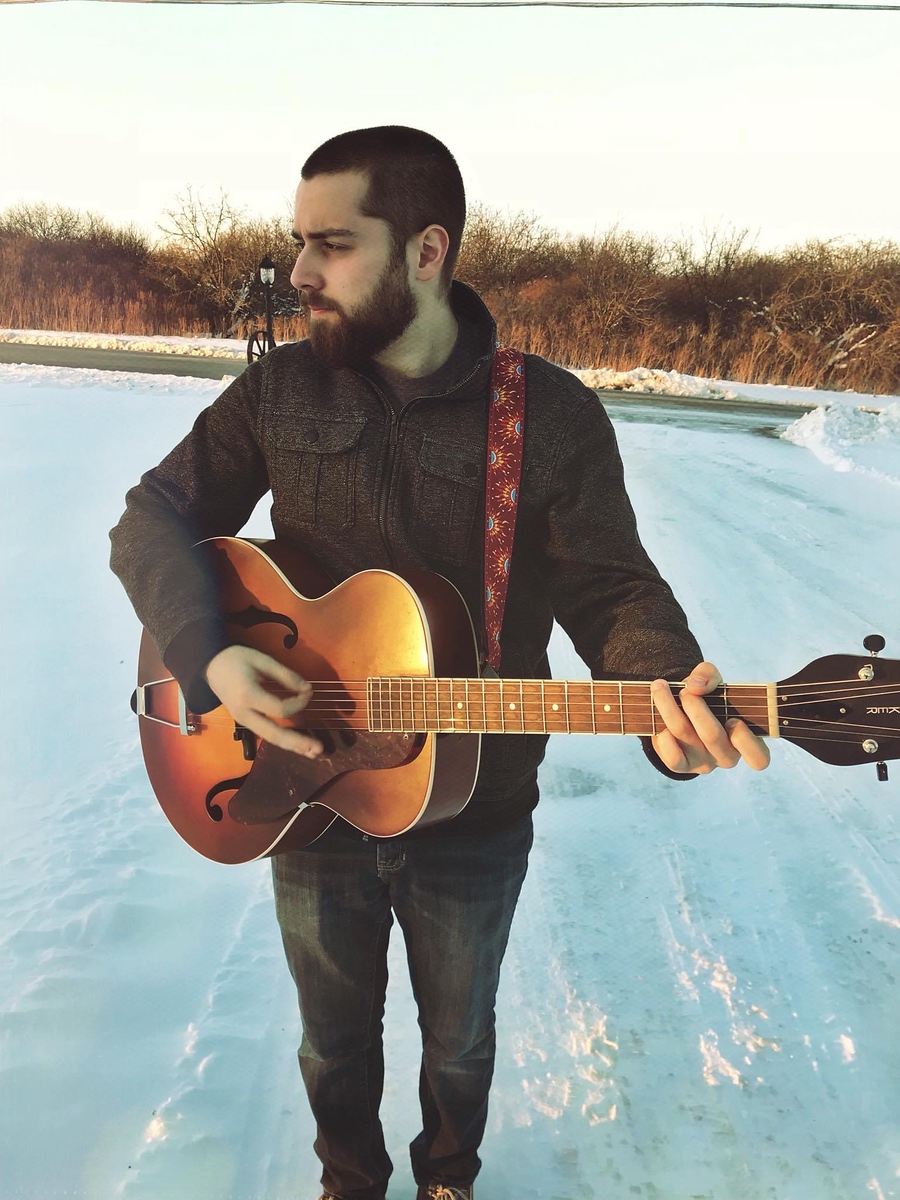
Outdoors in the snow with “Gretschen,” a Gretsch New Yorker archtop that’s Patrick’s favorite guitar for songwriting.
“I was 14 and went to see The Hobbit: The Desolation of Smaug with my best friend. As the ending credits rolled and we were walking out, I See Fire by Ed Sheeran came on. We literally turned around and walked back into the theater to hear the rest of the song. And when I heard the riff that starts in after the introduction line, I was, like, ‘I need to get a guitar!’ It really inspired me to think maybe, just maybe, I could write a song.”
And inspire, it did.
The middle schooler begged his parents for a guitar and received a used, small-bodied acoustic model that cost a whopping $85. Three days later, Patrick amazed his parents by playing his guitar (which he had learned to play by watching YouTube videos) and singing a song. His parents were even more surprised to learn their son had actually written the song he had performed in their living room.
Within a few months, Patrick knew he had found his calling: writing songs and making music. “I’ve always been a fan of poetry, literature, and writing,” says Patrick. “I’m also a Star Wars and fantasy nerd. When I was ten years old, I wrote a book called ‘Galaxy Wars.’ I also journal a lot. I’ve written books about my songs and how they came to be and where I was when I wrote them; maybe someday I’ll publish them. So, yes, my love for writing definitely carried over into lyricism. I’m super obsessed with lyrics.”
The depth and maturity of Patrick’s song lyrics have had many people shaking their heads in disbelief the past five years. “I guess I’m a bit of an older soul, I suppose,’ shares Patrick. “People have asked me how I was writing these deep songs at 15, 16, or 20-years-old. It just comes from what I call ‘somewhere else;’ the way I think when I’m sitting around. I’m a night owl and stay up real late hours of the night and kind of let my brain wander. I like keeping my creative mind conscious, front and center, and letting it wander wherever it wants to.”
Patrick played his first gig at the age of 15 in 2015. A year later, while most 16-year-olds were focused on getting their driver’s licenses, Patrick was busy recording and releasing his first studio album entitled “The Wanderer.” The album contained a dozen original songs and was recorded in Nashville at Southern Ground Nashville, Zac Brown’s recording studio. Grammy-winner Brandon Bell was the sound engineer and one of the producers.
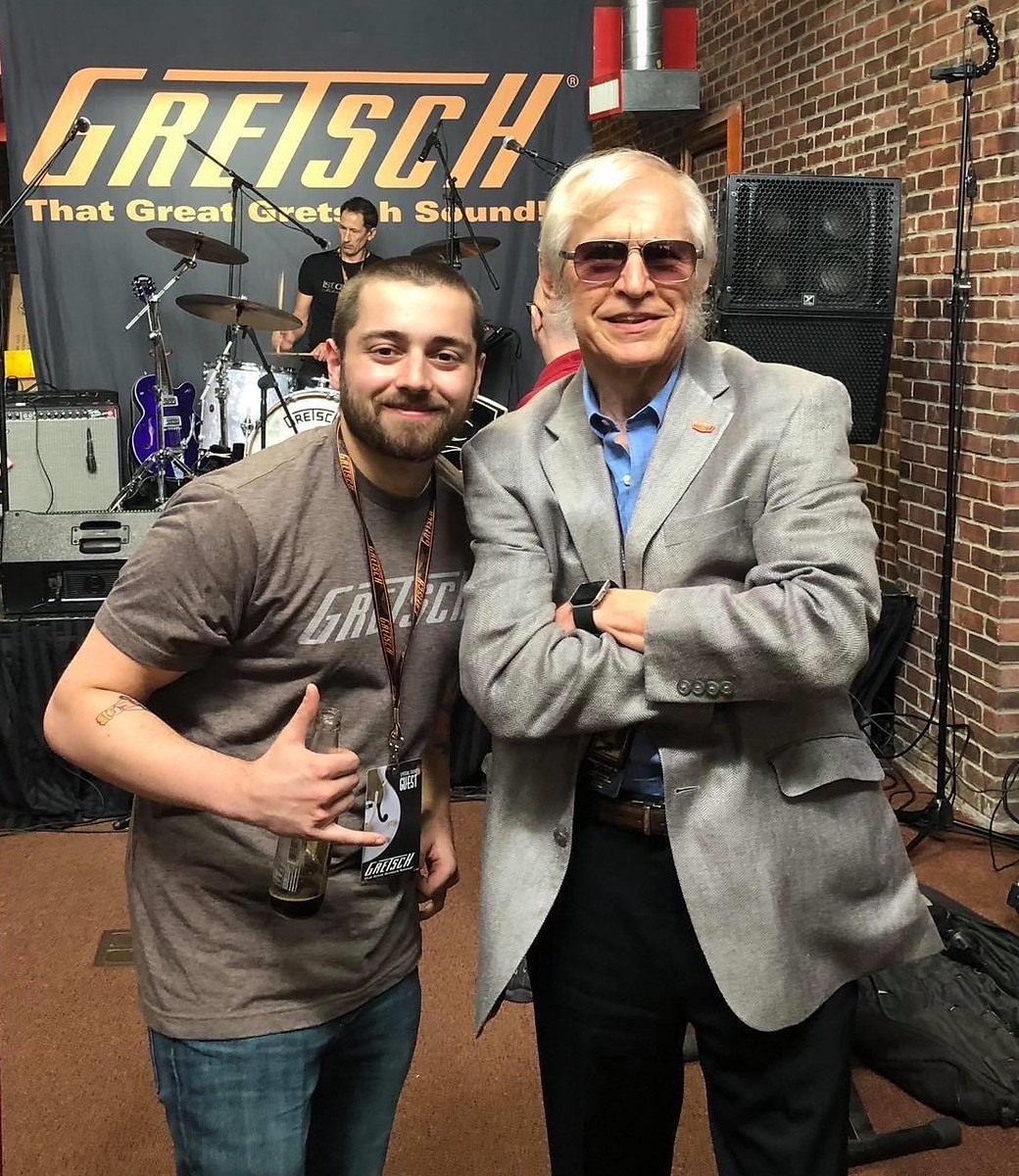
Patrick and Fred Gretsch at the 2018 Gretsch Day event at Street Sounds in Brooklyn, NY.
A year later, Patrick’s hard work and tireless efforts of writing, gigging, recording, and posting his songs and performances on social media paid off. Videos of Patrick performing with his favorite songwriting guitar, a Gretsch New Yorker archtop acoustic he named Gretschen, eventually found their way to Joe Carducci, Senior Product Manager for Gretsch Guitars. Carducci liked what he saw, and Patrick became one of Gretsch Guitar’s youngest endorsers at the age of 17. Patrick was even invited to perform at the 2018 Gretsch Day event a Street Sounds in Brooklyn that celebrated the Gretsch Company’s 135th Anniversary.
Over the past 18 months, Patrick has continued to write songs, perform, and grow his social media fanbase (his Facebook followers now exceed 55,000). He’s also released three singles: “Good Guys,” “Gentle Conversation,” and “Fly With Her,” and was recently featured as one of a dozen Gretsch Endorsed artists on the cover of the Gretsch House Telegram newsletter.
Although quarantined in his upstate New York hometown of Watertown (population 25,290), Patrick remains a ball of creative energy. He just celebrated the five-year anniversary of his first gig with a live stream performance and is working out the song selection for his upcoming second album. He continues to write new songs, practice fingerpicking on his Gretsch acoustics, and cranks it up to play blues rock on one of his Gretsch electrics.
After a few minutes on the phone with Patrick, you have to remind yourself that you’re talking to a 20-year-old. His maturity, knowledge, focus, energy, and overall passion for what he calls “his craft” of telling stories through his songs just oozes out. It’s easy to see why this personable young singer-songwriter continues to turn heads and gain new fans every day.
You became a Gretsch Endorsed Artist at 17. What does that mean to you?
Just to be a part, in a small way, of a legacy that grand is still mind blowing. You do feel a bit of a responsibility, but it’s ever so motivating to keep trying to pick away at the craft, day-in-and-day-out, because if feels like you’re a part of something that’s more than just your sound. There’s a legacy there that you kind of have to hold up to and I love that. Even though it comes with responsibility, it comes with an honor as well. It’s a very cool thing.
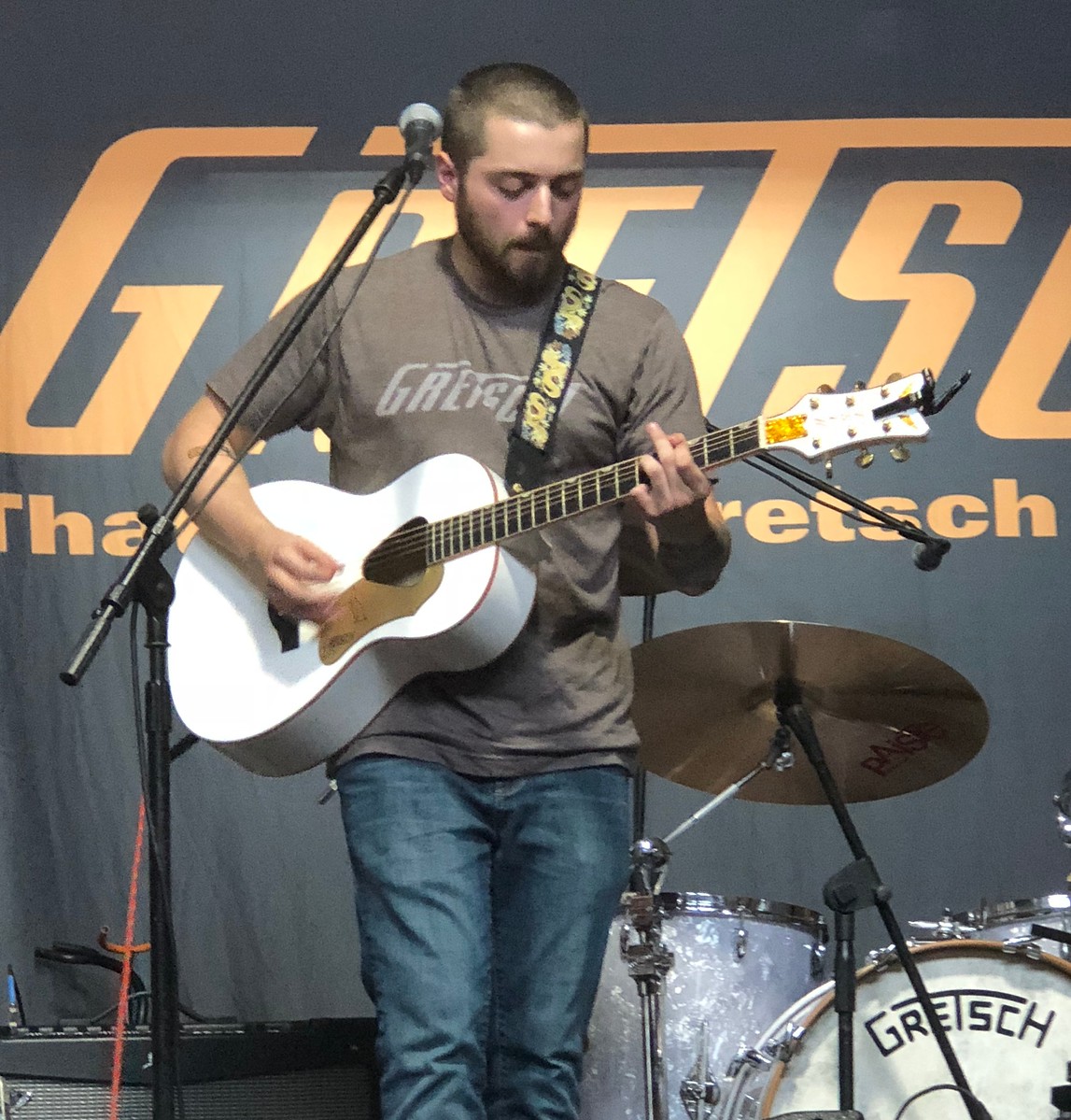
Patrick performing at the 2018 Gretsch Day event at Street Sounds in Brooklyn, NY.
You perform primarily with a Rancher Penguin Parlor acoustic/electric guitar. What made you choose that guitar?
My first guitar was a small-bodied guitar and I just liked the looks of the Penguin. It’s flashy, but in the coolest way, and I had never been into thinking I wanted a white guitar with gold trim and the bright headstock with the wings. It sounds so big for a smaller-bodied guitar and it plays awesome; like, the neck is so easy. I play a lot of lead on that guitar and rhythm too, and I play it at every live show. We spend a lot of time together. We’ve gotten to know each other really well.
What was the first Gretsch guitar you owned?
One day, a guy at a local guitar shop showed me a Gretsch G9550 New Yorker, the acoustic archtop that’s a remake from the 40s models. I was entranced. I had always been fascinated with the look and mystique of archtop guitars. I bought it that day and I must’ve logged 10,000 hours on it the first day I had it. That’s why I fell in love with Gretsch. I’ve even given her a name: Gretschen, and she’s still my favorite guitar and best songwriting buddy. We hang out together quite a bit.
Any other Gretsch guitars in your arsenal?
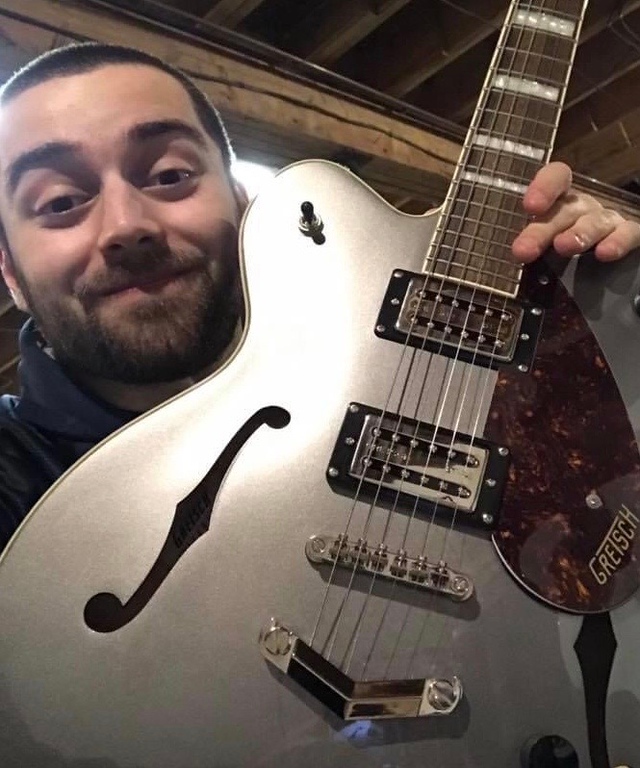
Patrick with his new Streamliner Center Block Double-Cut.
Yes, I have several cool electrics. I have an Aspen Green 5420T that I also like to write songs on because of the insane tones you can reach on that guitar, especially blues tones. That guitar is a beast! I also have a white Electromatic Center Block Jr. That one has more bite, a little bit of that harder tone, that crunchier tone that sometimes I’m looking for. And my latest is a Streamliner Center Block Double-Cut. That thing rips! It’s a true rocking guitar. And like my other Gretsches, it has versatile tones, but that thing can grind, and it’s beautiful, too. That Phantom Metallic finish is one of my favorites that they’ve done.
What music or musicians influence you the most?
I draw my inspiration from a lot of musicians and various kinds of music. My dad say’s I’m a big music sponge. I’d say my biggest influencers are Foy Vance, Bon Iver, Amos Lee, Gregory Alan Isakov, Ben Howard, Gary Clarke Jr., John Mayer, James Taylor and Harry Chapin. Oh, and Stevie Ray Vaughn and B.B. King. Even instrumental music, like, soundtracks from John Williams, Howard Shore, and Hans Zimmer. All kinds of different symphonic composers that I find so awesome who inspire me to listen a little bit bigger, if you know what I mean.
Any particular musician inspiring you the most these days?
Probably Ben Howard. His album I Forget Where We Were, is an amazing soundscape of a record that is inspiring me the most right now.
I hear you like “rinsing” other musicians for inspiration. What does that mean?
Yeah, I’ll rinse an artist, as they say, which means I’ll grab an artist for a month and I’ll do nothing but listen to that artist and study how they progressed from record-to-record. And I find that it will, even inadvertently, inspire my own songwriting.
What’s your process for creating and writing songs?
A lot of the times, it starts with messing around with the guitar to find the kind of idea I want. But there are times I’m driving down the road to the gym, or whatever, and a lyric will pop into my head and I’ll record it really quick on my voice memo or write it down in my notes and then I’ll come back and make something of it.
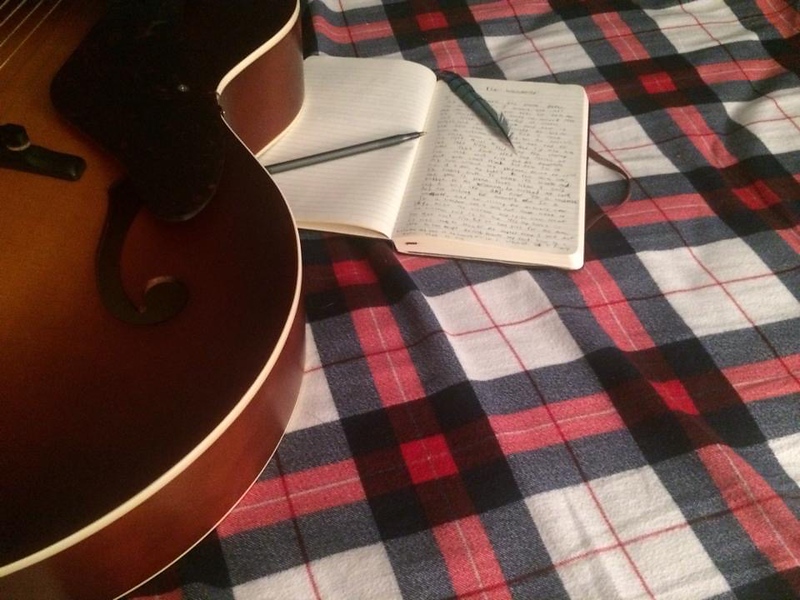
Patrick’s songwriting tools: his “Gretschen” guitar, a journal, and a pen.
What was the first story song you wrote that gave you the confidence to go further with your music?
I’d say it was “The Wanderer.” I wrote that song when I was 15; about eight months after I started playing guitar and that was a genuine story song. I started playing it to people I hung out with and they said, “That’s a great story song,” and I’m a huge fan of James Taylor and storywriters like Harry Chapin. And it’s so funny, because, after that moment, it all clicked.
“Gentle Conversation” is a moving song about reconnecting with a person from your past. What’s the story behind that song?
It was written after a breakup I had and reconnecting with a friend. She had traveled a lot and we hadn’t talked in years. We just talked about life, and time, and where it takes you, and I thought those conversations were so special because they came at the right time that I needed someone to talk to, but not to vent or to rant. Genuinely, just to have, no pun intended, a “gentle” conversation, just a talk. There’s a line in the song that says, “God’s got a funny way of letting people in/And the simple things mean more to me than most things ever did.” And I think that’s the embodiment of that whole idea.
I’ve heard you say that where and when you hear a song can be as important as a song’s lyrical message.
Yes. I have so much music that I love that means something to me because of where I heard it and when I heard it, not necessarily because the song says this is what this is about. So, I think a lot of the music has come from various moments of my life. Gregory Alan Isakov says it best, “After the song is out, it’s none of my business.” And I love that line because so many of us grasp music in our own ways, and not necessarily what they were written for. Sometimes there’s a mystique to the lyrics or maybe they are more poetic or indirect, but for the person listening, it might mean fifty different things.
Your fans seem to emotionally connect with your songs. What do you hear from them?
They do and I’ve been getting a lot of heavy messages from fans lately. Someone going through an extremely difficult time or an extremely good time, and somehow the music helped them through the situation or made the time better. They’ll say, ‘Thank you for the music’ and that is so beautiful.
Is there a song you wrote that surprised you on how it connected with your fans?
Yes, there’s a song from my first album called “Hero,” and I wrote that song because I’ve always been fascinated with fantasy and film and I was watching TV shows like Arrow and The Flash. It’s kind of got a darker edge to it but I didn’t expect that one from all the songs to click, let alone be one of my most popular ones. It’s nearly five years old and still gets requested on every stream I do. I mean, I always thought it might be a cool song, but I never thought it would be, like, that one.
What kind of songs do you like writing these days?
True-life story songs. Songs that come from truly experiencing life and taking notes. For example, I was visiting a friend and his girlfriend, and she happened to say, in a joking way, ‘I’m only here for the interesting.” Whoa, I had to write that down and it became part of a new song called Mistfell. Listening to what was being said around me and making a song story about it was one of my favorite experiences writing a song, for sure.
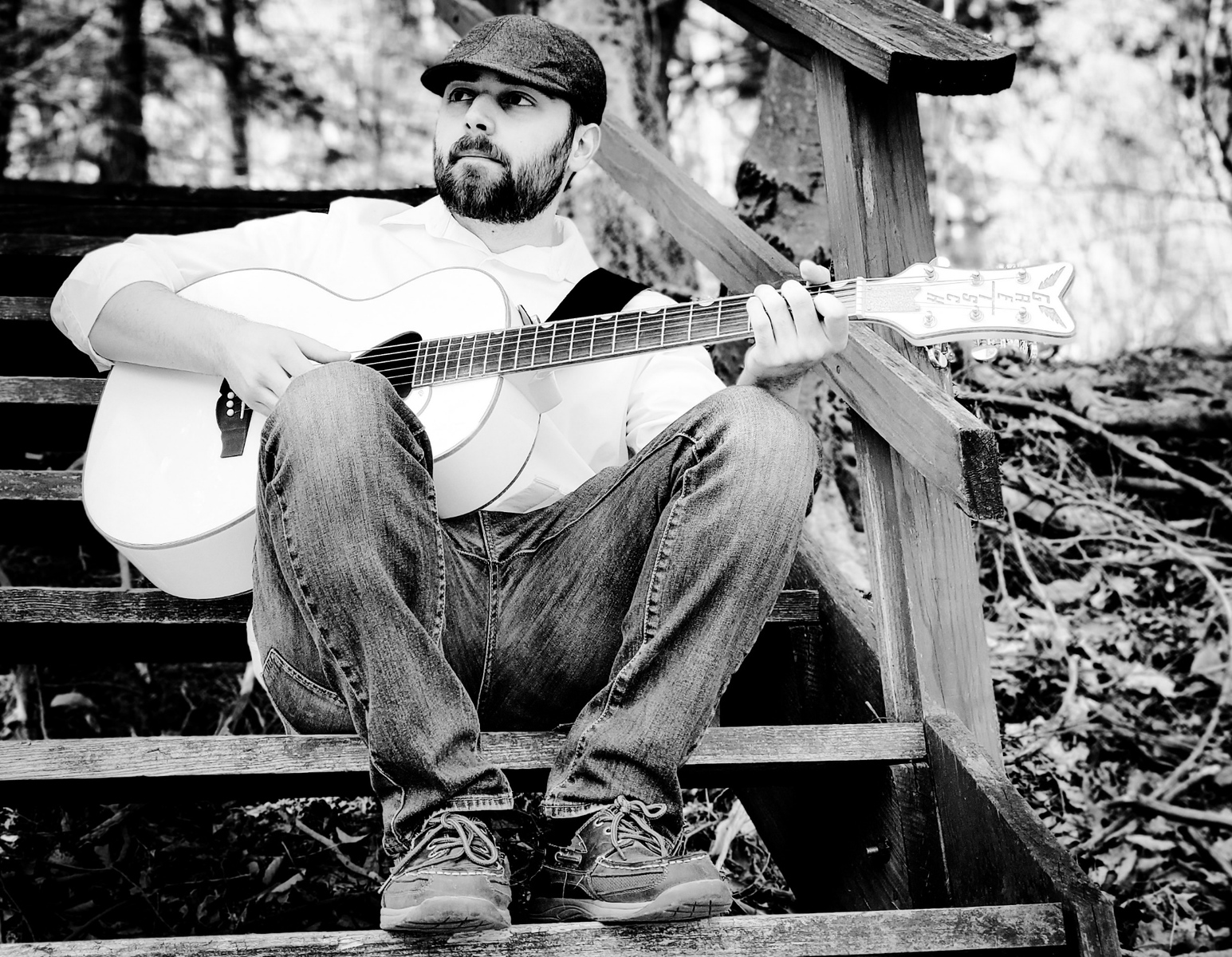
Recent photo of Patrick outside on steps playing his Rancher Penguin Parlor guitar. Photo by Emory Joyce.
What can you tell us about your upcoming album?
I’m super excited about it. It’s going to be longer than my first album, 17 or 18 tracks, all original songs. I’m still bouncing around with the track list a bit. I promise not to say this in an arrogant way, but I think it’s the best it can be at this time. I’ve put together a conglomerate piece and I think people from front-to-back are going to be able to say this is something special that I will listen to for a long time.
What are you doing to keep yourself busy during this time of quarantining?
These are definitely strange times. I’ve been writing songs, practicing guitar, and streaming live on Facebook and keeping busy. I’m so thankful for the technology that can keep me connected. I’ve had to cancel shows and not be able to go to the gym and other things that frees my mind, but you can’t do anything about this situation. But you can try to take this time and make it into something artistic, creative, and maybe even beautiful. So that when this thing ends, we have something to show for it.
What advice do you have for other young, aspiring musicians?
I suppose I’m not much of an advice giver because I don’t know how to dictate someone’s creativity, because mine is so different than the next person. I just tell people what my dad told me once: Listen to as much music as you can and from as many styles and influences as possible. It might subconsciously inspire you 15 years from now and you’d never even know it.
You shared that Ed Sheerin’s “I See Fire” started you on your songwriting journey six years ago. What do you think when you hear that song today?
It’s the one that first inspired me to try and write a song. And to this day, it’s one of my favorite songs of all time. I still listen to it every day.”
Be sure to follow Patrick on Instagram, Facebook, and YouTube.
Enjoy this video of Patrick performing a live version of “Gentle Conversation,” a single he released in 2019.
Feature photo by Emory Joyce.



 Previous
Previous